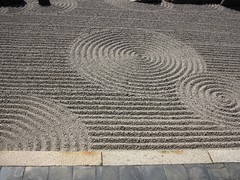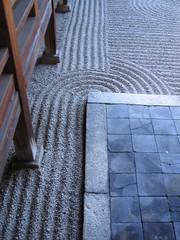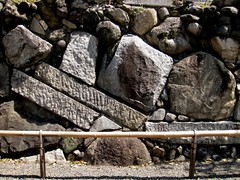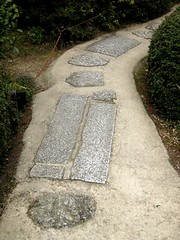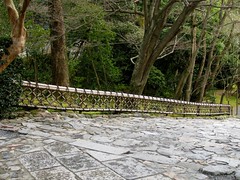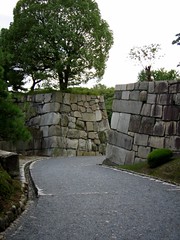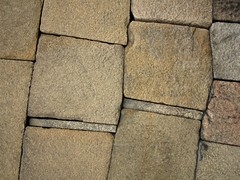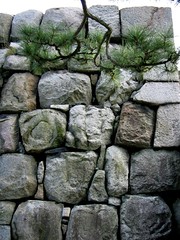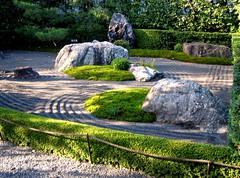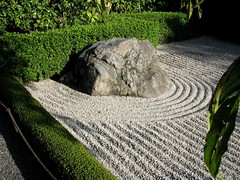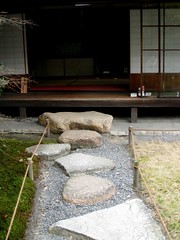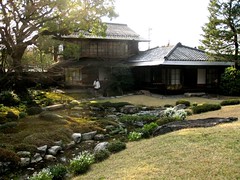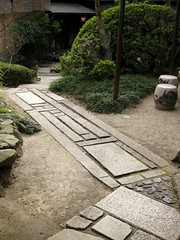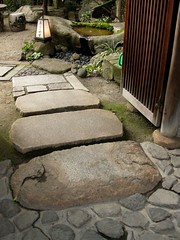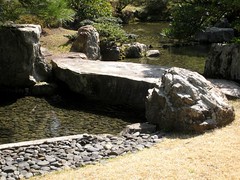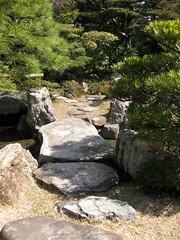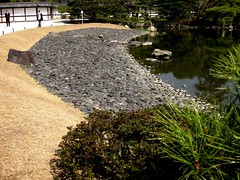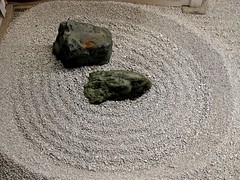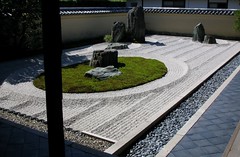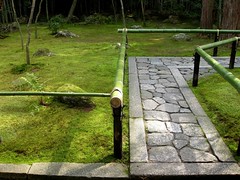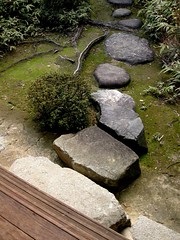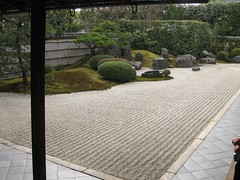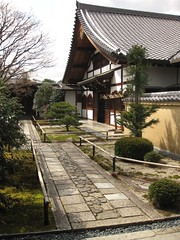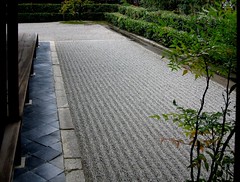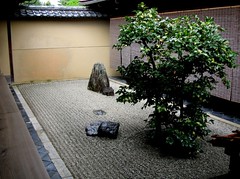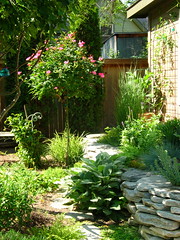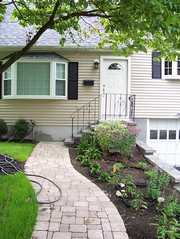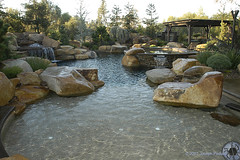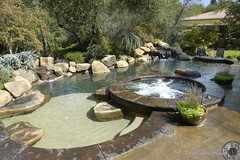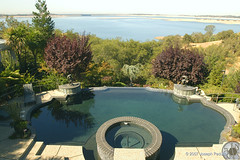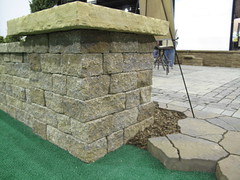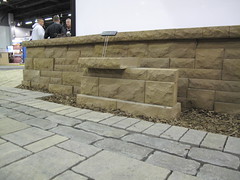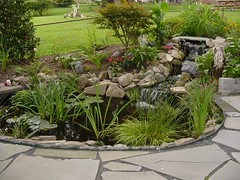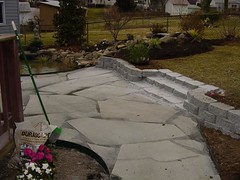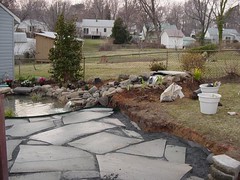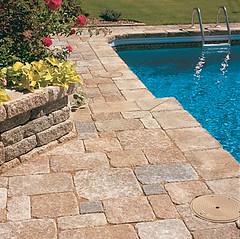Sand detail at pavement
4/01/2010
rubble wall (Taka-ishigaki).jpg
Shosei-in (Kikoku-tei [the Orange Grove])
Kikokutei is the name of a detached residence belonging to Higashi Hongan-ji Temple.
Kikokutei is the name of a detached residence belonging to Higashi Hongan-ji Temple.
path.JPG
Shoren-in, is one of the five Monzeki temples of the Tendai sect in Kyoto and was formerly part of the Enryaku-ji Temple on Mt. Hiei.
shoden-ji bowl.jpg
We were the only people, besides a monk, the day we visited. It was raining and the monk had set this bowl outside to catch the water. Not strictly a religious fountain, but close.
Ryoan-ji, fence & Pilgrim's Path.jpg
A gorgeous exit. This fence is known as ryouanjigaki, 龍安寺垣, and is characterized by thick split bamboo that cross diagonally to form a diamond pattern. These are secured by a base made of two heavy split bamboo pieces and a top rail of split bamboo that has a larger diameter than the cross-members. The rail is crowned with a coping of heavy split bamboo. Jaanus
Ryoan-ji (they have their own website). The temple site was originally a Fujiwara family estate, then passed to the Hosokawa clan. Hosokawa Katsumoto lived there before the Ōnin War and willed the war-ravaged property to a Rinzai Zen sect after his death.
Ryoan-ji (they have their own website). The temple site was originally a Fujiwara family estate, then passed to the Hosokawa clan. Hosokawa Katsumoto lived there before the Ōnin War and willed the war-ravaged property to a Rinzai Zen sect after his death.
3/31/2010
Murin-an entry.jpg
Murin-an is the former villa of Yamagata Aritomo, statesman of the Meiji and Taisho periods. The estate was constructed in 1894 as a stroll garden, designed by Yamagata, around streams fed by the Lake Biwa Canal and incorporating Higashiyama (the Eastern Hills) as borrowed scenery. Along with Shisendo-do, Murin-an provides an opportunity to see an elegant private family residence--as opposed to temple and garden. In 1941 the property was donated to the city of Kyoto which holds it as a cultural asset.
Murin-an house.jpg
Murin-an is the former villa of Yamagata Aritomo, statesman of the Meiji and Taisho periods. The estate was constructed in 1894 as a stroll garden, designed by Yamagata, around streams fed by the Lake Biwa Canal and incorporating Higashiyama (the Eastern Hills) as borrowed scenery. Along with Shisendo-do, Murin-an provides an opportunity to see an elegant private family residence--as opposed to temple and garden. In 1941 the property was donated to the city of Kyoto which holds it as a cultural asset.
small restaurant3.jpg
I stood at the gate taking photos. Wish I'd gone in.
Higashiyama (east mountain) is in the east of Kyoto against wooded hills. Many sites central to Japanese culture are there: the geisha district of Gion, the Yasaka Shrine, Kiyomizu Temple, Tōfuku-jii, and Sanjūsangen-dō are all within a day's stroll, unless you actually enter one of these sites, any of which by themselves can absorb you for many hours. Higashiyama is also great for random photography.
Higashiyama (east mountain) is in the east of Kyoto against wooded hills. Many sites central to Japanese culture are there: the geisha district of Gion, the Yasaka Shrine, Kiyomizu Temple, Tōfuku-jii, and Sanjūsangen-dō are all within a day's stroll, unless you actually enter one of these sites, any of which by themselves can absorb you for many hours. Higashiyama is also great for random photography.
small restaurant1.jpg
I stood at the gate taking photos. Wish I'd gone in.
Higashiyama (east mountain) is in the east of Kyoto against wooded hills. Many sites central to Japanese culture are there: the geisha district of Gion, the Yasaka Shrine, Kiyomizu Temple, Tōfuku-jii, and Sanjūsangen-dō are all within a day's stroll, unless you actually enter one of these sites, any of which by themselves can absorb you for many hours. Higashiyama is also great for random photography.
Higashiyama (east mountain) is in the east of Kyoto against wooded hills. Many sites central to Japanese culture are there: the geisha district of Gion, the Yasaka Shrine, Kiyomizu Temple, Tōfuku-jii, and Sanjūsangen-dō are all within a day's stroll, unless you actually enter one of these sites, any of which by themselves can absorb you for many hours. Higashiyama is also great for random photography.
Gonaitei garden-stone bridge.jpg
Gonaitei is a small garden running along a stream north of Oike niwa garden.
In 794 Kyoto (then Heiankyo) became the capital under Emperor Kanmu. The Gosho---Imperial Palace---was at the north end of the city. As it burned repeatedly, the emperor took refuge at other palaces. The current site became the permanent palace in 1331 under Emperor Kogon and remained so until the capital was moved to Tokyo in 1869. The new palace also burned, and was rebuilt in 1788 and again in 1854. This is the palace we see today.
In 794 Kyoto (then Heiankyo) became the capital under Emperor Kanmu. The Gosho---Imperial Palace---was at the north end of the city. As it burned repeatedly, the emperor took refuge at other palaces. The current site became the permanent palace in 1331 under Emperor Kogon and remained so until the capital was moved to Tokyo in 1869. The new palace also burned, and was rebuilt in 1788 and again in 1854. This is the palace we see today.
Gonaitei garden path.jpg
Gonaitei is a small garden running along a stream north of Oike niwa garden.
In 794 Kyoto (then Heiankyo) became the capital under Emperor Kanmu. The Gosho---Imperial Palace---was at the north end of the city. As it burned repeatedly, the emperor took refuge at other palaces. The current site became the permanent palace in 1331 under Emperor Kogon and remained so until the capital was moved to Tokyo in 1869. The new palace also burned, and was rebuilt in 1788 and again in 1854. This is the palace we see today.
In 794 Kyoto (then Heiankyo) became the capital under Emperor Kanmu. The Gosho---Imperial Palace---was at the north end of the city. As it burned repeatedly, the emperor took refuge at other palaces. The current site became the permanent palace in 1331 under Emperor Kogon and remained so until the capital was moved to Tokyo in 1869. The new palace also burned, and was rebuilt in 1788 and again in 1854. This is the palace we see today.
Oike niwa garden-shore.jpg
Oike niwa is a stroll garden, situated around a large pond with bridges and a boat-mooring dock on the rocky shore.
In 794 Kyoto (then Heiankyo) became the capital under Emperor Kanmu. The Gosho---Imperial Palace---was at the north end of the city. As it burned repeatedly, the emperor took refuge at other palaces. The current site became the permanent palace in 1331 under Emperor Kogon and remained so until the capital was moved to Tokyo in 1869. The new palace also burned, and was rebuilt in 1788 and again in 1854. This is the palace we see today.
In 794 Kyoto (then Heiankyo) became the capital under Emperor Kanmu. The Gosho---Imperial Palace---was at the north end of the city. As it burned repeatedly, the emperor took refuge at other palaces. The current site became the permanent palace in 1331 under Emperor Kogon and remained so until the capital was moved to Tokyo in 1869. The new palace also burned, and was rebuilt in 1788 and again in 1854. This is the palace we see today.
Ginkakuji interior garden.jpg
The temple of Jisho-ji is known as Ginkaku-ji, the Silver Pavilion, begun in 1482. It was the retirement villa of Ashikaga Yoshimasa, 8th Shogun of the Muromachi Period. The complex became the very center of Japanese aesthetic concerns during Yoshimasa's residency, particularly in the areas of art collecting, flower arranging, and the tea ceremony. (From Bowdoin College. Ginkaku-ji has become a tourist vortex, but it's hard to exaggerate it's importance to Japanese esthetics. I recommend: "Yoshimasa and the Silver Pavilion: The Creation of the Soul of Japan" by Donald Keene.
Totekiko, Ryogen-in.jpg
Ryogen-in is a subtemple of Daitoku-ji. It was founded by Tokei Soboku in 1502. Within or adjoining the abbot's residence are five gardens of which the Totekiko is the smallest recognized dry garden (karensansui) in Japan.
Totekiko, Ryogen-in.jpg
Ryogen-in is a subtemple of Daitoku-ji. It was founded by Tokei Soboku in 1502. Within or adjoining the abbot's residence are five gardens of which the Totekiko is the smallest recognized dry garden (karensansui) in Japan.
Koto-in entry path.jpg
A branch of Daitokuji Temple founded in 1601 by Hosokawa Tadaoki (1563-1645). A great and famous warrior, Hosokawa fought under Toyotomi Hideyoshi in Korea and supported Tokugawa Ieyasu in the establishment of his shogunate. His wife, Gratia (or Gracia), was both a devout follower of the banned Catholic church and the daughter of Akechi Mitsuhide who attacked Oda Nobunaga and caused his death by seppuku.
Koto-in steps and path.jpg
A branch of Daitokuji Temple founded in 1601 by Hosokawa Tadaoki (1563-1645). A great and famous warrior, Hosokawa fought under Toyotomi Hideyoshi in Korea and supported Tokugawa Ieyasu in the establishment of his shogunate. His wife, Gratia (or Gracia), was both a devout follower of the banned Catholic church and the daughter of Akechi Mitsuhide who attacked Oda Nobunaga and caused his death by seppuku
Korin-in, side path.jpg
Korin-in, a sub-temple of Daitoku-ji, was founded by Yoshifusa Hatekeyama, a warlord of the Noto (now Ishikawa) Prefecture, in 1521-23. The hojo (main building) and other elements are in the Muromachi style. It has a famous tea room, Kankyo-tei, and a great dry garden. Korin-in is normally closed except for a couple of times each year. We got lucky.
Korin-in, dry garden.jpg
Just love this azalea wrapping around rocks.
Korin-in, a sub-temple of Daitoku-ji, was founded by Yoshifusa Hatekeyama, a warlord of the Noto (now Ishikawa) Prefecture, in 1521-23. The hojo (main building) and other elements are in the Muromachi style. It has a famous tea room, Kankyo-tei, and a great dry garden. Korin-in is normally closed except for a couple of times each year. We got lucky.
Korin-in, a sub-temple of Daitoku-ji, was founded by Yoshifusa Hatekeyama, a warlord of the Noto (now Ishikawa) Prefecture, in 1521-23. The hojo (main building) and other elements are in the Muromachi style. It has a famous tea room, Kankyo-tei, and a great dry garden. Korin-in is normally closed except for a couple of times each year. We got lucky.
Korin-in, dry garden.jpg
Korin-in, a sub-temple of Daitoku-ji, was founded by Yoshifusa Hatekeyama, a warlord of the Noto (now Ishikawa) Prefecture, in 1521-23. The hojo (main building) and other elements are in the Muromachi style. It has a famous tea room, Kankyo-tei, and a great dry garden. Korin-in is normally closed except for a couple of times each year. We got lucky.
Korin-in, dry garden.jpg
Korin-in, a sub-temple of Daitoku-ji, was founded by Yoshifusa Hatekeyama, a warlord of the Noto (now Ishikawa) Prefecture, in 1521-23. The hojo (main building) and other elements are in the Muromachi style. It has a famous tea room, Kankyo-tei, and a great dry garden. Korin-in is normally closed except for a couple of times each year. We got lucky.
Korin-in, main entry.jpg
Korin-in, a sub-temple of Daitoku-ji, was founded by Yoshifusa Hatekeyama, a warlord of the Noto (now Ishikawa) Prefecture, in 1521-23. The hojo (main building) and other elements are in the Muromachi style. It has a famous tea room, Kankyo-tei, and a great dry garden. Korin-in is normally closed except for a couple of times each year. We got lucky.
Daisen-in north garden.jpg
A small karesansui; the 1st garden you see.
Daisen-in, a subtemple of Daitoku-ji, was founded in 1509 by Zen priest Kogaku Soko (1464-1548). The gardens date from about that time and may have been designed by Kogaku or perhaps by the painter Soami, who did the landscape paintings in the main hall. The garden is a miniature landscape with mountains, waterfalls and river and wraps entirely around the main hall (hojo).
Daisen-in, a subtemple of Daitoku-ji, was founded in 1509 by Zen priest Kogaku Soko (1464-1548). The gardens date from about that time and may have been designed by Kogaku or perhaps by the painter Soami, who did the landscape paintings in the main hall. The garden is a miniature landscape with mountains, waterfalls and river and wraps entirely around the main hall (hojo).
IMG_1936.JPG
Hardscape North America 2009 Trade show, Atlanta - GA
01/15/2009-01/17 2009 Hardscape North America 2009 Trade show, Atlanta - GA
01/15/2009-01/17 2009 Hardscape North America 2009 Trade show, Atlanta - GA
BelAir Wall
Hardscape North America 2009 Trade show, Atlanta - GA
01/15/2009-01/17 2009 Hardscape North America 2009 Trade show, Atlanta - GA
01/15/2009-01/17 2009 Hardscape North America 2009 Trade show, Atlanta - GA
Subscribe to:
Posts (Atom)
